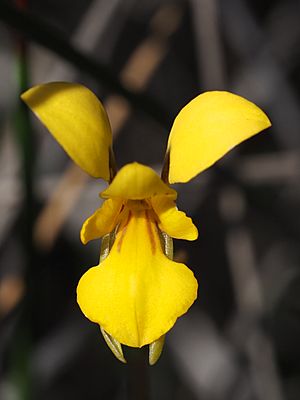Nanny goat orchid facts for kids
Quick facts for kids Nanny goat orchid |
|
|---|---|
 |
|
| Diuris laevis near Madfish Bay in the William Bay National Park | |
| Scientific classification | |
| Genus: |
Diuris
|
| Species: |
laevis
|
The Diuris laevis, also known as the nanny goat orchid, is a special and rare type of orchid. It only grows in the south-west part of Western Australia. This means it is endemic to that area.
This orchid usually has four to eight twisted leaves. Its flowers are pale yellow, often with reddish-brown spots. There can be up to six flowers on one stem. The Nanny Goat Orchid has a unique short top petal, called a dorsal sepal. It also has a wide lower petal, called a labellum. You can find it quite often between the towns of Bunbury and Albany.
Contents
What the Nanny Goat Orchid Looks Like
The Nanny Goat Orchid grows from a tuber (like a small potato). It is a perennial plant, meaning it lives for more than two years. It is also a herb, so it has soft stems, not woody ones.
Leaves and Flowers
This orchid has between four and eight leaves. These leaves are spirally twisted. They are about 50 to 120 millimetres (2–5 inches) long. They are also about 2 to 3 millimetres (0.08–0.1 inches) wide.
The plant can have up to eight pale yellow flowers. These flowers often have reddish-brown markings. Each flower is about 20 to 35 millimetres (0.8–1.4 inches) long. They are also about 18 to 30 millimetres (0.7–1.2 inches) wide. These flowers grow on a stem that is 200 to 350 millimetres (8–14 inches) tall.
Petals and Sepals
The top petal, called the dorsal sepal, points upwards. It is about 9 to 12 millimetres (0.4–0.5 inches) long. It is also about 4 to 6 millimetres (0.16–0.24 inches) wide and tapers to a point. The two side sepals stick out forwards. They are about 17 to 22 millimetres (0.7–0.9 inches) long and 3 to 4 millimetres (0.1–0.2 inches) wide.
The two main petals stand upright and are spread apart. They are egg-shaped. Each petal is about 8 to 10 millimetres (0.3–0.4 inches) long. They are also about 7 to 9 millimetres (0.3–0.4 inches) wide. These petals sit on a brown stalk that is about 4 to 5 millimetres (0.16–0.20 inches) long.
Labellum Details
The lower petal, called the labellum, is about 13 to 16 millimetres (0.5–0.6 inches) long. It has three parts, or lobes. The middle lobe is broadly egg-shaped. It is about 11 to 13 millimetres (0.4–0.5 inches) long. It is also about 12 to 14 millimetres (0.5–0.6 inches) wide. The two side lobes are about 6 to 8 millimetres (0.2–0.3 inches) long. They are about 3 to 4 millimetres (0.1–0.2 inches) wide and have jagged edges.
There are two flat ridges on the labellum. These are called callus ridges. They are about 4 to 5 millimetres (0.16–0.20 inches) long. They run along the middle of the labellum.
Flowering Time
The Nanny Goat Orchid usually flowers in October and November. It produces many more flowers after a bushfire.
Naming the Nanny Goat Orchid
The scientific name for this orchid, Diuris laevis, was first officially described in 1882. This was done by a person named Robert FitzGerald. His description was published in a magazine called The Gardeners' Chronicle.
The second part of its scientific name, laevis, comes from a Latin word. This Latin word means "smooth," "polished," or "bald."
Where the Nanny Goat Orchid Lives
The nanny goat orchid grows in areas that are wet in winter. It can also be found in swamps. Often, many of these orchids grow together. You can find them between Bunbury and Albany. These areas are part of the Esperance Plains, Jarrah Forest, and Warren biogeographic regions. These regions are special areas based on their plants and animals.
Conservation Status
The Western Australian Government's Department of Parks and Wildlife has looked at the Nanny Goat Orchid. They have classified Diuris laevis as "not threatened." This means it is not currently at risk of disappearing.

